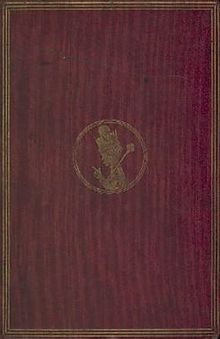 First edition cover of Through the Looking-Glass | |
| Author | Lewis Carroll |
|---|---|
| Illustrator | John Tenniel |
| Language | English |
| Genre | Children's fiction |
| Publisher | Macmillan |
Publication date | 27 December 1871 (dated 1872) |
| Publication place | United Kingdom |
| Pages | 208 |
| Preceded by | Alice's Adventures in Wonderland |
Through the Looking-Glass, and What Alice Found There (also known as Alice Through the Looking-Glass or simply Through the Looking-Glass) is a novel published on 27 December 1871 (although it is indicated[where?] that the novel was published in 1872[1]) by Lewis Carroll, a mathematics lecturer at Christ Church, University of Oxford, and the sequel to Alice's Adventures in Wonderland (1865). Alice again enters a fantastical world, this time by climbing through a mirror into the world that she can see beyond it. There she finds that, just like a reflection, everything is reversed, including logic (for example, running helps one remain stationary, walking away from something brings one towards it, chessmen are alive, nursery rhyme characters exist, and so on).
Through the Looking-Glass includes such verses as "Jabberwocky" and "The Walrus and the Carpenter", and the episode involving Tweedledum and Tweedledee. The mirror above the fireplace that is displayed at Hetton Lawn in Charlton Kings, Gloucestershire (a house that was owned by Alice Liddell's grandparents, and was often visited by Alice and Lewis Carroll) resembles the one drawn by John Tenniel, and is cited as a possible inspiration for Carroll.[2] The novel prompted a new-found appreciation for its predecessor when it was published.[3]
- ^ Oxford Companions. 1986. Oxford Companion to English Literature (5th Ed.).
- ^ Carroll, Lewis (1997). Lewis Carroll's Diaries: Containing Journal 8, May 1862 to September 1864. Lewis Carroll Society. p. 186.
- ^ Carpenter, Humphrey (1985). Secret Gardens: The Golden Age of Children's Literature. Houghton Mifflin. p. 68. ISBN 978-0-395-35293-9.